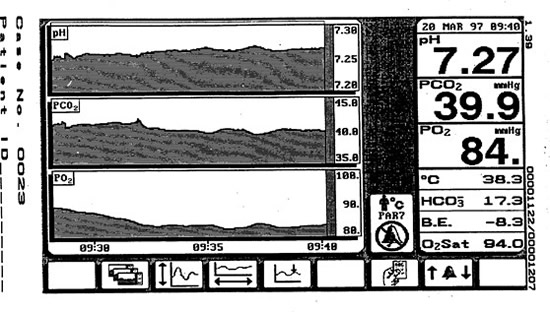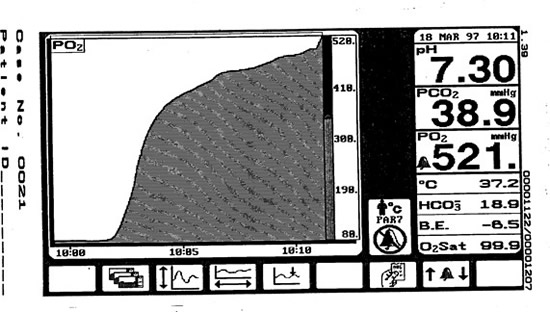Continuous Intra-arterial Monitoring of Blood Gases Using the Paratrend 7™: Applications in Nondomestic Species
Abstract
The Paratrend 7™ intravascular blood gas monitoring system (Biomedical Sensors, Pfizer Inc., New York, NY, USA) utilizes fiberoptics and electrochemical sensing elements to provide continuous blood gas monitoring (PO2, PCO2, pH, temperature, base excess, bicarbonate, O2 saturation) of patients. Monitoring of invasive blood pressures via an external transducer can be performed simultaneously with the Paratrend 7™. Currently, the most widely used method of blood gas monitoring is based on intermittent arterial blood gas sampling: this method only provides historical blood gas data. The main advantage of continuous intra-arterial blood gas monitoring (CBGM) is the ability to take immediate action based on the present blood gas status of the patient.1 Applications in human medicine have focused on high risk, critically ill, decompensating patients; particularly in pediatric medicine and with hypoxic and/or poorly perfused patients in which pulse oximetry is unreliable.2 The cost of the Paratrend 7™ ($25,000 for the unit and $300/single use sensors) will prohibit the routine use of this system in zoological medicine. However, the Paratrend 7™ would be invaluable for zoological veterinarians during anesthesia, drug, and procedural studies in which trends (Figure 1) and effects (Figure 2) of these variables on the blood gas status of patients should be recorded. Surgical procedures on “high profile and/or high risk patients” could also be more safely performed using CBGM of the patient’s status. In this talk, we present the design and function of the Paratrend 7™ and applications in non-domestic species.
Figure 1. Paratrend 7™ three parameter trend display of cheetah blood gases during Telazol/medetomidine anesthesia study

A fall in the PO2 value is shown during a few minute period.
Figure 2. Paratrend 7™ single parameter trend display of cheetah PO2 during Telazol/medetomidine anesthesia study

Starting at 10:02, 2 L of supplemental oxygen were delivered by endotracheal tube. A rise in PO2 is shown shortly after oxygen supplementation was begun.
Acknowledgments
The authors thank Mr. Ron Bobele for information on the Paratrend 7™ system.
Literature Cited
1. Szaflarski, N.L. 1996. Emerging technology in critical care: continuous intra-arterial blood gas monitoring. Am. J. Crit. Care. 5:55–65.
2. Dirks, J.L. 1995. Innovations in technology: continuous intra-arterial blood gas monitoring. Crit. Care Nurse. April Pp.19–27.